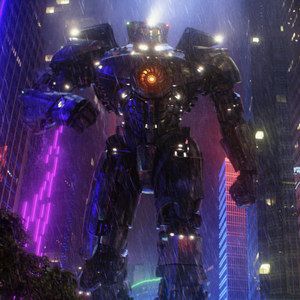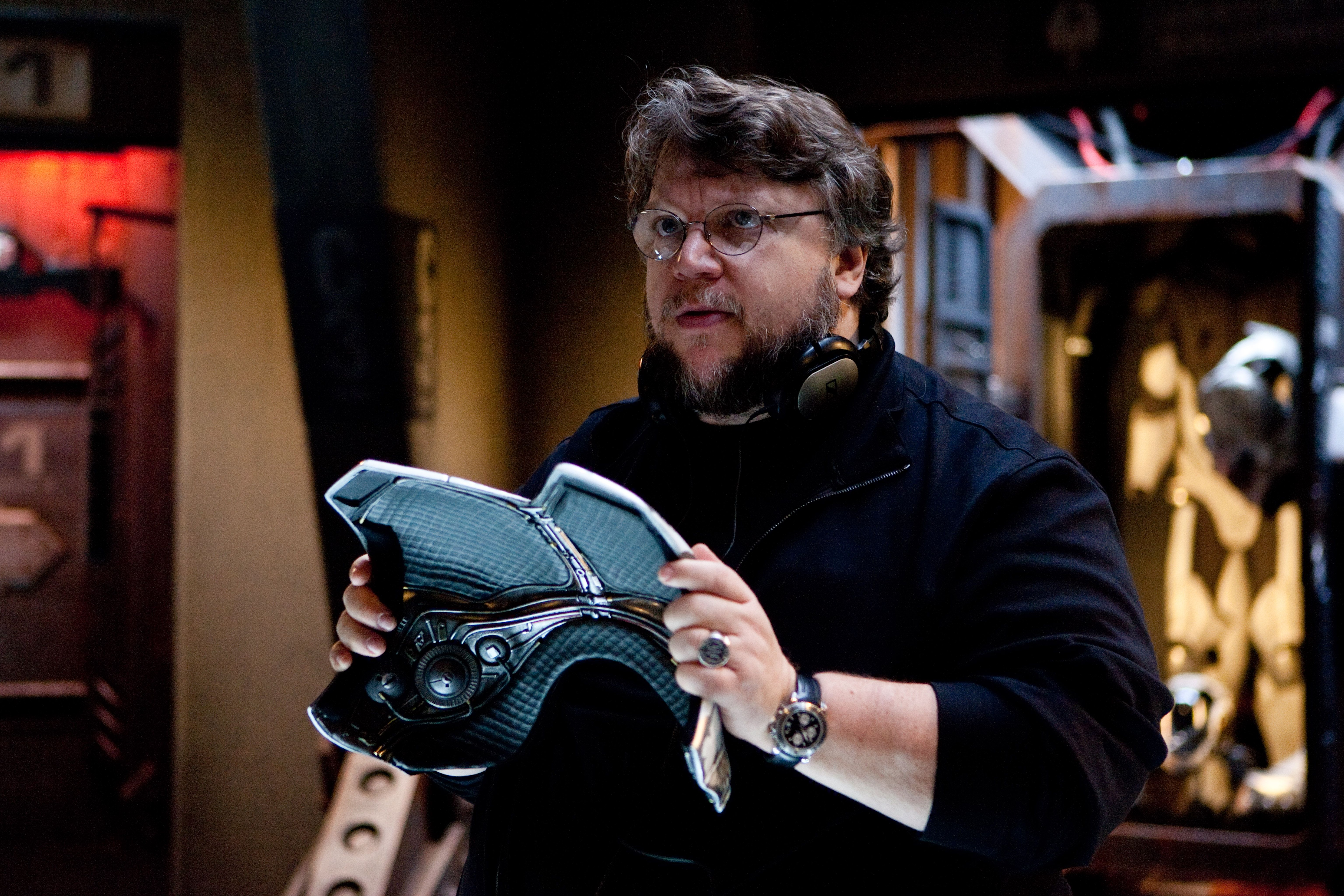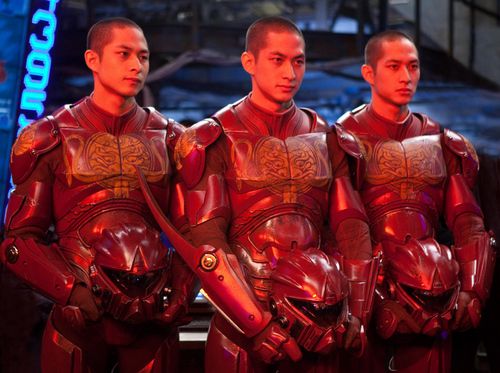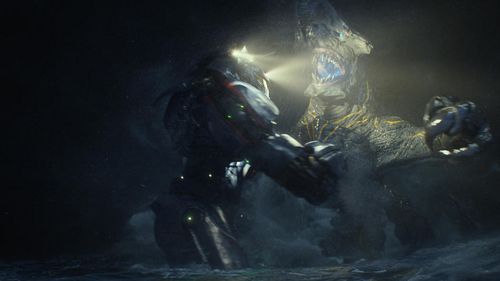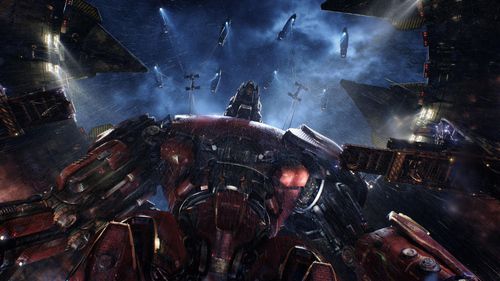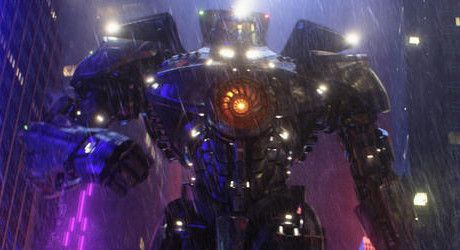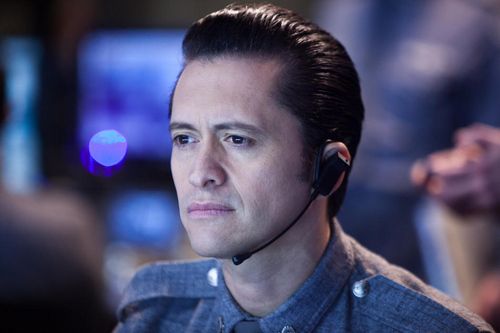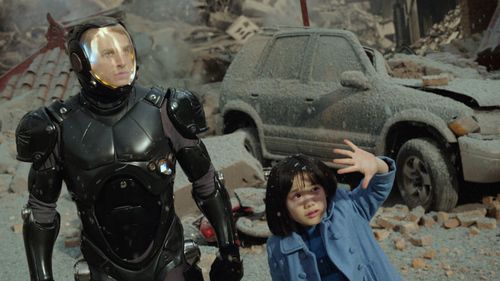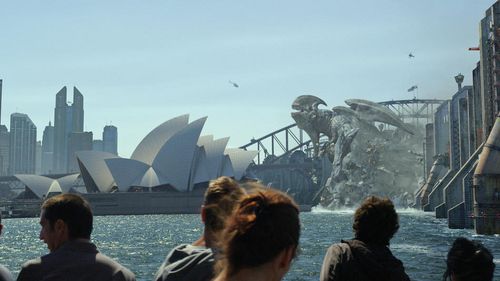We visit the set of Pacific Rim, where Guillermo del Toro takes us deep inside this battle against monsters and robotos, in theaters this July
(*This story is from contributing writer Chase Whale.)
In April 2013, we(*) flew to Canada to spend the day at the very busy Pinewood Studios touring sets and interviewing cast and crew members for a kind-of-a-big-deal movie. There, the great Guillermo del Toro was in mid-production shooting his love letter to Kaiju monsters, Pacific Rim (101 sets in 103 days). Stop me if you've heard this before (actually, let me finish because this is probably going to sound familiar), but talking to Guillermo del Toro about movies is unreal. This man is a fanboy first, filmmaker second. He can (and will) talk for hours about monsters, movies, and all things imagination. Watching him direct is some next world kind of shit.
The day we were on set, we watched him direct a tattooed, punk rock-looking Charlie Day running through the aftermath of a destroyed Hong Kong as a Kaiju monster is chasing after him, flipping cars and crushing every person and object in its path. We didn't get to see the actual monster (they're all CGI), but watching Guillermo del Toro direct a scene on a set that left me slack-jawed was good enough for me. The best part of this visit was watching him call "ACTION!" for each take. It was like watching a cinematic opera: Very loud, very long, and very, very profoundly awesome.
The only bummer about being on the set this day was that they were shooting a very important scene in the film. And as much as everyone tried to hide certain details that were being shot, Charlie Day accidentally slipped a major spoiler (which we've omitted, so you can breathe easy). Champagne problem for us because I watched part of the ending of the movie play out while on set. But lucky for you, you're in for a monstrous treat when you finally see the finished product in a theater later this July.
"It's going to be unlike anything you've seen before."
While on set, we were treated to an interview with director Guillermo del Toro, as well as costume designer Kate Hawley, visual effects supervisor John Knoll and production designer Andrew Neskoromny.
Here is our conversation with maestro Guillermo del Toro:
What makes the Kaiju different from the other monsters you've worked with over the years?
Guillermo del Toro: Are you talking about actors? [Laughs] The quicker answer is scale. We have to think about the Kaijus like the largest monster ever. Elemental on Hellboy II: The Golden Army, that's the biggest one. It was like five, six stories high. The Kaiju's are 25 stories high. So they're huge. Another big, big difference is that I have used monsters in identifiable, sort of sympathetic ways and the Kaiju are like an earthquake or a tornado or a hurricane; they're a force of nature. They are essentially blind to any moral or ethical circumstances. They're fast. If there's a city or a predator or a highway they just move. So that is a big, big difference.
What has it been like working on such a monumental scale compared to some of your smaller pieces?
Guillermo del Toro: The funny thing is that a lot of the smaller movies have been pretty big. Not so much in terms of budget but in terms of technical complexity. Hellboy II: The Golden Army had sequences that are as complicated as this. We didn't have the budget to do it every x number of times. With Hellboy I had to always choose just one big sequence, two or three set pieces that were smaller, and this movie, part of the statement as a concept, and just an intrinsic part of the narrative is scale. Humans against the things that are gigantic, the human melodrama and the human spirit against the background of huge, immense odds.
What's the most important part of someone else's script that makes you want to take it on as your own?
In the sizzle reel we saw, you said that you were trying to resurrect a spirit that doesn't exist these days in film anymore. What's that spirit?
Guillermo del Toro: Just adventure. Instead of having the idea of just bad guys and good guys, to have the idea that you can dream about. When I was a kid and you saw a space movie or a cowboy movie you dreamt, "I want to be a cowboy" or "I want to be a spaceman". And I wanted very much to create a movie that hopefully young viewers can go "I want to be a Jaeger pilot." The spirit of adventure where you're not cynical, you're not jaded. You're going into it in earnest. I've never ever made a movie that has full, modern irony. Ever. The Hellboy movies are completely earnest. Whether they work or not for someone that's a different matter. I just approach them with no tongue in cheek about the material. I have a blue guy, I have a red guy, and a guy made of gas, and I direct them without any hierarchy. And I think the spirit in adventure movies is an earnest, very beautiful sort of human spirit.
Which is funny because I get a lot of Starship Troopers from this, which as a book is not earnest. It's very tongue in cheek.
Guillermo del Toro: Yeah, and the movie is very dark and ironic. Pacific Rim is not ironic. Starship Troopers goes from the point of view of the winners, therefore they take their cues from a very oppressive militarized society that essentially creates soldiers. Their approach is to satirize fascism. And we come from the point of view that we are vanquished. We are the resistance. We are coming at the moment when you must keep calm and carry on. You know, rationing. People are hungry, people are working for food. Humanity is not triumphant. We are trying to build a wall that is 300 miles around the coastline, it's an uninhabited force all across the pacific. Food is the coin of the realm. We are at the lowest and at the lowest we take the approach that we are not going with white teeth, blonde hair, super Aryan heroes coming to save humanity. We're going with a Japanese girl, an Australian team, Charlie Day, Idris Elba, we have a Peruvian-Chinese that is played by Clifton Collins Jr.. So we are saying there's not a race that's going to save the planet, there's not a country that's going to save the planet. We're sort of anti-jingoistic and I made it a point that when the movie starts there's still a military structure, but by minute 20 these guys are absolutely the resistance. The machines are being repaired vicariously; they are being serviced by people that just are doing it out of passion, out of faith. There is no military uniforms, no salutes, no military structure for the rest of the film. One of the things I did very deliberately in order to evoke adventure was to strip, after the first 50 minutes, the characters of all their terms. We call them "ranger" and "marshall" and we call the Jaeger "riding" a Jaeger. I wanted sort of a Western film. Marshalls and Rangers manning a station. I know it sounds ironic coming from a Mexican. But the Alamo [laughs]. But the idea was to evoke a frontier pulse that is the last standing post on Earth. All the other Jaeger posts are closed. So completely opposite [from Starship Troopers].
It seems like Newt and Hannibal have a great dynamic together. How did you balance humor with the earnestness of the film?
How did these giant monsters get on Earth?
Guillermo del Toro: Through a portal. The whole backstory centers on a mysterious portal that opens up in the Pacific Ocean in the year 2013. Pacific Rim is set 12 years in the future, after most of humanity has banded together to try and figure out a way to fight the swarms of monsters that are popping out of this portal. Thus creating the 250-foot to 280-foot-tall Jaegar robots.
What was the inspiration starting the story 12 years into it as opposed to doing an origin story?
Guillermo del Toro: Because the part that I was interested in was the part where things are hard. I cannot tell you how much I didn't want to make a war movie. I didn't want to make it a war movie, I wanted to make it an adventure movie. I wanted very much to contrast the moment where it was going well but you were deep into it. Because if you start with the origin then you have to go with investigative characters which are very hard for me to relate to. You know like a reporter or military forensics. For me it has to be a character that has something against him or her from the get go. Like a character that starts already oppressed or down on his or luck for me to be interested.
You mentioned in the sizzle reel that this world is bigger than anything you can imagine. What were some of the challenges of making a world that's bigger than anything you can imagine?
It's really interesting that you brought on a lead actor who's never done studio action films before, he's done mostly comedy. What was it about Charlie Day that made you take that leap of faith?
Guillermo del Toro: You know, I'm a huge fan of It's Always Sunny in Philadelphia, but I'm a huge fan without thinking of Charlie for anything, I was just a huge fan and we had Newt as a character. One day in one of the episodes of It's Always Sunny in Philadelphia he has a monologue about rats. He comes out with a stick and he has a monologue about what it is to hang the rats in the basement, and he was very funny but he was coming from character. He was not doing big stuff, he was really mourning and lamenting his job, how inhuman it is. And I thought this guy is really good at shading and is great at comedy. There are moments in the movie where he delivers them both and I'm extremely happy about that. I think at that point I didn't know any movies he had done in comedy, I only saw It's Always Sunny in Philadelphia from the beginning until now. I watch as much TV as I humanly can. Right now I'm stuck on the third season of Justified and I'm going to watch episode 13 tonight [Laughs]. If it doesn't hook me I don't watch it, but I watch every pilot I can.
What does having two Jaeger pilots set up for your characters? What sort of problems arise?
Guillermo del Toro: The first idea that I wanted to have is that the neural surge is so big that you need somebody to link the right hemisphere and someone to link the left hemisphere. And I wanted to explore how some of the characters would not get along in real life, actually hate each other, but they're good at something. You know like, I was never a great dancer obviously, but as a kid ,as you saw couples that fought all the time, but they danced beautifully together and I thought this would be great to have two characters that hated each other, but when the time comes they can pilot, they're good at that. They can black out all the differences and come together. The movie is not an individual thing, coming together is what saves us. The Kaijus are completely individualistic, sheer force, and the pilots need to join together. Most of the characters in the movie don't get together and then they come together and it works. Which I think is what it means to be human. It's been in Hellboy, Hellboy II: The Golden Army and The Devil's Backbone, those are essentially the ideas. So I guess I was preempted by that. One of the things I love most about the bomber movies is the communication between the cockpit and the crew; I love that dynamic and I wanted to give the film the dynamic of being really there and there's always so much more when you have somebody looking at someone and sharing an experience but being alone. I thought it would be more interesting. If you have a girl and she sits next you and you have to share everything you are in a single fashion, like best worst memories, she knows what music you like, she knows your picture all in one instance, and then they can fall in love, I thought that was very nice. I thought that was really quite beautiful.
How heavy on the references to other monster movies will Pacific Rim be? Are we going to see a "man in a suit" kind of monster?
Ron mentioned that you purposefully wanted to leave his character's back story a little vague. Let the audience fill in the blanks. Why did you think that would work with Hannibal?
Guillermo del Toro: Because I think that the moment you have a guy named Hannibal Chau and Ron Perlman shows up, and he's from Brooklyn and he's selling black market organs. You know the whole story. I took my name from my favorite historical character and the next one from my favorite restaurant in Brooklyn. Why do you need a backstory from that? [Laughs]
Costume designer Kate Hawley, visual effects supervisor John Knoll and production designer Andrew Neskoromny were also on hand to discuss some of the various aspects of the production.
Why are all the Jaegars different from each other?
How many Kaijus are we going to see stomping around our cities?
Andrew Neskoromny: The audience will witness about eight to 10 monsters in battle. But they will also see Kaiju carcasses, and a closer look at Kaiju brains and intestines and skulls. There are A LOT of monsters, and when the Jaegers win, the body of the Kaiju falls where it died. Leaving a giant rotting carcass. The future humans have found away to make these dead things work. We even saw a bit of concept art where the skeletal remains of a Kaiju had been turned into a church, worshiping the monsters. No clue if that art made it into the movie, but it stuck with us.
There's lots of aesthetics, especially in the sets, that make you feel like a monster is ready to come out. Is there any particular film that you pulled your set or production design inspiration from?
Andrew Neskoromny: In terms of Hong Kong, we did use a little bit of reference but we amped it up a little bit. It was more based on actual research. Going to Hong Kong, photographing what you like, getting great reference, and then just tweaking it into our own world and degrading it. Because we are trying to say that this is the end of the world. When one of our characters, Newt, makes his journey into Hong Kong he's trying to find the sort of key that will end this war and save the world. So by the time they get into Belcher street and all that it's very decayed. Things are stained blue, like literally the bile from the creatures is infecting the entire area. On Belcher Street there is a very large Kaiju carcass that's in one direction of the shot that will be added in by a visual effect. But the whole idea is that that skeletal remain is infecting the entire area.
Why is everything blue?
Kate Hawley: That's Kaiju blood. Giant monsters have a crap load of giant blu blood in them. And it gets everywhere. The entire world is starting to turn blue. One particular scene set on Belcher street in Hong Kong is basically swimming in Indigo dye because of the seepage of monster blood.
One of the first early interviews we had with Ian he said that Guillermo was very insistent on robots not moving like people, he wanted them to move like robots. Which is interesting because almost all Kaiju films are people in suits, and I was wondering if there's anything he left up to you guys that had touches of all the old Kaiju films.
We've been seeing a lot of really beautiful and big monster movies and robot movies for many years now, going back to Jurassic Park and then Cloverfield. Are there any things that you see, as someone who works in this industry, in monster movies that are challenges or frustrating that you would like to change in this film?
Andrew Neskoromny: That's an interesting question. I wouldn't say that the things that are problematic are things that we're going to change. But I will say that one of the things that I like about the movie is that, and this is not so much in terms of reference you spoke about, but I think that when people think about monster movies they don't think of them necessarily as sophisticated as they actually are. If you've ever seen the original Japanese Godzilla it's a very dark and sophisticated movie; and that's what I think Guillermo del Toro, with his aesthetic and his character design, and his storytelling is bringing to this. It's a very serious and kind of heavy overtone to the world when we're under attack. Which is not to say the movie is always dark, there's a kind of weighty feel to this battle between humans and the Kaiju. So to me, it sort of goes back to what I think the roots of the Kaijus are and the effects of the original Godzilla. That's one of the things I like about the story.
(*This story is from contributing writer Chase Whale.)

